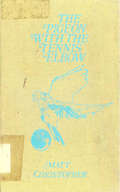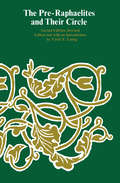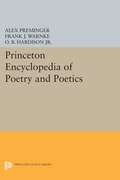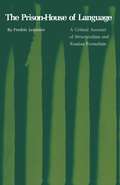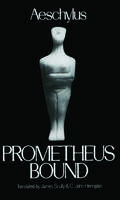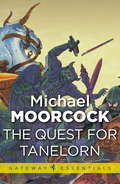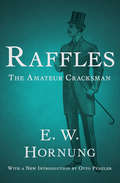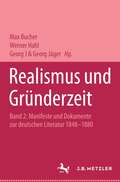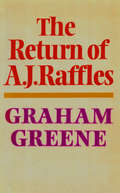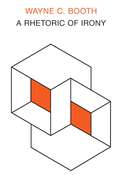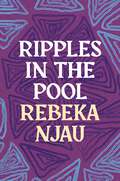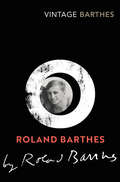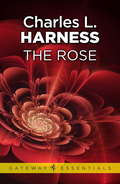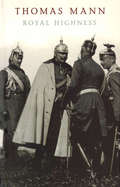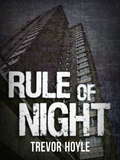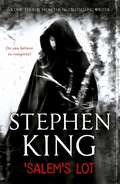- Table View
- List View
The Pigeon With the Tennis Elbow
by Matt ChristopherKevin O'Toole, playing in a tennis tournament, meets a talking pigeon who turns out to be his great uncle and gives him tennis tips.
The Pre-Raphaelites and Their Circle
by Cecil Y. LangThis useful volume presents the major works of the five leading Pre-Raphaelite poets. Foremost in the collection, and included in their entirety are D. G. Rossetti's The House of Life, C. G. Rossetti's "Monna Innominata," William Morris's "Defence of Guenevere," Swinburne's Atalanta in Calydon, and Meredith's "Modern Love." Complementing these major poems is a fine, generous selection of the poets' shorter pieces that are typical of their work as a whole. For this second edition, Cecil Lang has substituted two early Swinburne poems, "The Leper" and "Anactoria," for Fitzgerald's The Rubáiyát of Omar Khayyám. These poems, which the editor describes as "shocking," show a new aspect of Swinburne not discussed previously. Lang's Introduction describes briefly the founding of the Pre-Raphaelite Brotherhood, discusses each of the Pre-Raphaelite poets, both individually and in relation to the others, and grapples with the questions of definition of Pre-Raphaelitism and the similarities between its painting and poetry. The book is appropriately illustrated with thirty-two works by D. G. Rossetti, John Ruskin, William H. Hunt, and other Pre-Raphaelite artists. This is the only anthology available that provides a representative selection of the work of these important poets. It will be indispensable to students of Victorian poetry and appreciated by readers interested in the Pre-Raphaelites.
The Pre-Raphaelites and Their Circle
by Edited by Cecil Y. LangThis useful volume presents the major works of the five leading Pre-Raphaelite poets. Foremost in the collection, and included in their entirety are D. G. Rossetti's The House of Life, C. G. Rossetti's "Monna Innominata," William Morris's "Defence of Guenevere," Swinburne's Atalanta in Calydon, and Meredith's "Modern Love." Complementing these major poems is a fine, generous selection of the poets' shorter pieces that are typical of their work as a whole. For this second edition, Cecil Lang has substituted two early Swinburne poems, "The Leper" and "Anactoria," for Fitzgerald's The Rubáiyát of Omar Khayyám. These poems, which the editor describes as "shocking," show a new aspect of Swinburne not discussed previously. Lang's Introduction describes briefly the founding of the Pre-Raphaelite Brotherhood, discusses each of the Pre-Raphaelite poets, both individually and in relation to the others, and grapples with the questions of definition of Pre-Raphaelitism and the similarities between its painting and poetry. The book is appropriately illustrated with thirty-two works by D. G. Rossetti, John Ruskin, William H. Hunt, and other Pre-Raphaelite artists. This is the only anthology available that provides a representative selection of the work of these important poets. It will be indispensable to students of Victorian poetry and appreciated by readers interested in the Pre-Raphaelites.
The Pre-Raphaelites and Their Circle
by Cecil Y. LangThis useful volume presents the major works of the five leading Pre-Raphaelite poets. Foremost in the collection, and included in their entirety are D. G. Rossetti's The House of Life, C. G. Rossetti's "Monna Innominata," William Morris's "Defence of Guenevere," Swinburne's Atalanta in Calydon, and Meredith's "Modern Love." Complementing these major poems is a fine, generous selection of the poets' shorter pieces that are typical of their work as a whole. For this second edition, Cecil Lang has substituted two early Swinburne poems, "The Leper" and "Anactoria," for Fitzgerald's The Rubáiyát of Omar Khayyám. These poems, which the editor describes as "shocking," show a new aspect of Swinburne not discussed previously. Lang's Introduction describes briefly the founding of the Pre-Raphaelite Brotherhood, discusses each of the Pre-Raphaelite poets, both individually and in relation to the others, and grapples with the questions of definition of Pre-Raphaelitism and the similarities between its painting and poetry. The book is appropriately illustrated with thirty-two works by D. G. Rossetti, John Ruskin, William H. Hunt, and other Pre-Raphaelite artists. This is the only anthology available that provides a representative selection of the work of these important poets. It will be indispensable to students of Victorian poetry and appreciated by readers interested in the Pre-Raphaelites.
The Pre-Raphaelites and Their Circle
by Edited by Cecil Y. LangThis useful volume presents the major works of the five leading Pre-Raphaelite poets. Foremost in the collection, and included in their entirety are D. G. Rossetti's The House of Life, C. G. Rossetti's "Monna Innominata," William Morris's "Defence of Guenevere," Swinburne's Atalanta in Calydon, and Meredith's "Modern Love." Complementing these major poems is a fine, generous selection of the poets' shorter pieces that are typical of their work as a whole. For this second edition, Cecil Lang has substituted two early Swinburne poems, "The Leper" and "Anactoria," for Fitzgerald's The Rubáiyát of Omar Khayyám. These poems, which the editor describes as "shocking," show a new aspect of Swinburne not discussed previously. Lang's Introduction describes briefly the founding of the Pre-Raphaelite Brotherhood, discusses each of the Pre-Raphaelite poets, both individually and in relation to the others, and grapples with the questions of definition of Pre-Raphaelitism and the similarities between its painting and poetry. The book is appropriately illustrated with thirty-two works by D. G. Rossetti, John Ruskin, William H. Hunt, and other Pre-Raphaelite artists. This is the only anthology available that provides a representative selection of the work of these important poets. It will be indispensable to students of Victorian poetry and appreciated by readers interested in the Pre-Raphaelites.
Princeton Encyclopedia of Poetry and Poetics
by Alex Preminger Frank J. Warnke O. B. Hardison Jr.This comprehensive reference work deals with all aspects of its subject: history, prosody, types, movements, and critical terminology. Prepared by recognized authorities, its articles treat their topics in sufficient depth to be of value to the scholar as well as to the general reader.Originally published in 1975.The Princeton Legacy Library uses the latest print-on-demand technology to again make available previously out-of-print books from the distinguished backlist of Princeton University Press. These editions preserve the original texts of these important books while presenting them in durable paperback and hardcover editions. The goal of the Princeton Legacy Library is to vastly increase access to the rich scholarly heritage found in the thousands of books published by Princeton University Press since its founding in 1905.
The Prison-House of Language: A Critical Account of Structuralism and Russian Formalism
by Fredric JamesonFredric Jameson's survey of Structuralism and Russian Formalism is, at the same time, a critique of their basic methodology. He lays bare the presuppositions of the two movements, clarifying the relationship between the synchronic methods of Saussurean linguistics and the realities of time and history.
Prometheus Bound: Translated From The Greek (classic Reprint) (Greek Tragedy in New Translations)
by AeschylusFor readers accustomed to the relatively undramatic standard translations of Prometheus Bound, this version by James Scully, a poet and winner of the Lamont Poetry Prize, and C. John Herington, one of the world's foremost Aeschylean scholars, will come as a revelation. Scully and Herington accentuate the play's true power, drama, and relevance to modern times. Aeschylus originally wrote Prometheus Bound as part of a tragic trilogy, and this translation is unique in including the extant fragments of the companion plays.
The Quest for Tanelorn (Gateway Essentials #3)
by Michael MoorcockDorian Hawkmoon's dangerous quests through the multiverse have been successful and he has finally been reunited with his true love Yisselda, although his two children are still missing. Hawkmoon would move Heaven and Earth to find them - no idle boast when dealing with the multiverse - and soon finds himself on another quest. If he is to finally reunite his family, Hawkmoon must first find his way to the fabled city of Tanelorn...
Raffles: The Amateur Cracksman
by Otto Penzler E. W. HornungThe cracking debut of A. J. Raffles, proper English gentleman and jewel thief extraordinaireSometimes the greatest of partnerships are born in the direst of moments. For Bunny Manders and A. J. Raffles, such a moment comes when a bad night at the baccarat tables threatens to end in suicide. Hundreds of pounds in the red, Bunny grows so desperate that he asks Raffles, a former classmate who captained their public school’s cricket team, for help. When Raffles hesitates, Bunny pulls a gun out of his coat pocket and puts it to his head. “I never dreamt you had such stuff in you, Bunny!” says Raffles, a gleam in his eye. A few hours later, he and his old school chum break into a jeweler’s shop and steal thousands of pounds’ worth of diamonds and gemstones. Disaster averted, adventures begun. In these thrilling stories, E. W. Hornung introduced the world to a duo as gifted at burglary as Sherlock Holmes and Watson are at detection. Full of sophisticated banter, hair-raising close calls, and nefarious schemes, Raffles: The Amateur Cracksman is a masterwork of crime fiction and irrefutable proof that there truly is honor among thieves. This ebook features a new introduction by Otto Penzler and has been professionally proofread to ensure accuracy and readability on all devices.
Red Anger
by Geoffrey HouseholdGeoffrey Household returns to the rural England of Rogue Male and Watcher in the Shadows, with the savage hunting of his two heroes from the estuaries of South Devon to the empty Marlborough Downs.The novel reveals at last the fate of Alwyn Rory, the security officer who was believed to have taken a bribe to allow a naval spy to escape and to have defected to Russia rather than face trial. Both Rory and his new ally, Adrian Gurney, by whom the story is told, are on the run and may be killed with impunity, as they do not exist ...
Renegades of Time
by Raymond F. JonesThe Algorans. masters of time travel, had lost control of the time channels. In despair, they stood helplessly by as the barbarian hordes of the devastating Bakori were unleashed on the universe. In the little town of Midland, U.S.A., Joe Simmons worked feverishly to assemble the only device that had a chance to stop them. He knew that success depended on a beautiful Algoran woman, Tamarina, yet he didn't even know if she would re-appear! This whole disaster was his fault.
Retief: Emissary To The Stars (Retief)
by Keith LaumerTHE CORPS DIPLOMATIQUE TERRESTRIENNE HAS NEVER SEEN HIS LIKE...Retief - the most diplomatic diplomat of the 27th century.His mission: to gain control of the most desirable planet in the universe - without triggering intergalactic war.He tries talking ... but how does anyone - even Retief - negotiate with an uninhabited planet?He tries a dice game ... but how does gambling help the solar peace organization prevent the malevolent Basurans (who've eaten their own planet) from turning to Terra's prize colony for an after-dinner snack?The problems Retief faces are just beginning, but as insurmountable as they seem, the indomitable adventurer prevails - and keeps the state of the universe on an even keel!
Retief's Ransom (Retief)
by Keith LaumerLumbaga is a planet without known virtues - but with some decidedly odd natives. For every Lumbagan is simply an arbitrary assortment of semi-independent organs inspired by a lust for mayhem.But even the most undesirable chunk of galactic real estate attracts its quota of rival overlords, and the fiendish Groaci had a scheme for absorbing Lumbaga into their sphere of influence. It was working well, too, until it involved Retief, Terran diplomat extraordinary. To his powerful intellect, the machinations of the Groaci were child's play...
The Return Of A. J. Raffles: An Edwardian comedy in three acts based somewhat loosely on E.W. Hornung's characters in The Amateur Cracksman
by Graham GreeneThis play produced by the Royal Shakespeare Company has as its chief characters A. J. Raffles, the literary creation some seventy odd years ago of E. W. Hornung. The cool daring of the impeccable Amateur Cracksman, always torn between the rival claims of burglary and cricket, ensured his popularity in Edwardian England. Evading the dogged pursuit of Inspector Mackenzie of Scotland Yard, Hornung's character eventually met a hero's death in South Africa in the Boer War.Graham Greene's The Return of A. J. Raffles begins some months after. Raffles' loyal assistant Bunny still mourns his friend's death in Raffles' chambers in Albany, despite the blandishments of Lord Alfred Douglas. A visitor forces his way in - Raffles has cheated death as he once cheated Inspector Mackenzie - and immediately Lord Alfred sees in the Amateur Cracksman and Bunny heaven-sent instruments to revenge and disgrace of Oscar Wilde on his odious father, the Marquess of Queensberry...Graham Green never fails to surprise and delight admirers of his comic genius, and the twists and turns of this story of Edwardian high life, when Raffles returns to the scene of his earlier triumphs, provide a richly satisfying entertainment.
Rex is Out! (Nippers, Yellow Series)
by Marilyn Bloomfield"Suddenly he saw a flash of ginger. Something scampered past into a backyard doorway. Rex was out!"
A Rhetoric of Irony
by Wayne C. BoothPerhaps no other critical label has been made to cover more ground than "irony," and in our time irony has come to have so many meanings that by itself it means almost nothing. In this work, Wayne C. Booth cuts through the resulting confusions by analyzing how we manage to share quite specific ironies—and why we often fail when we try to do so. How does a reader or listener recognize the kind of statement which requires him to reject its "clear" and "obvious" meaning? And how does any reader know where to stop, once he has embarked on the hazardous and exhilarating path of rejecting "what the words say" and reconstructing "what the author means"? In the first and longer part of his work, Booth deals with the workings of what he calls "stable irony," irony with a clear rhetorical intent. He then turns to intended instabilities—ironies that resist interpretation and finally lead to the "infinite absolute negativities" that have obsessed criticism since the Romantic period. Professor Booth is always ironically aware that no one can fathom the unfathomable. But by looking closely at unstable ironists like Samuel Becket, he shows that at least some of our commonplaces about meaninglessness require revision. Finally, he explores—with the help of Plato—the wry paradoxes that threaten any uncompromising assertion that all assertion can be undermined by the spirit of irony.
The Rhinemann Exchange: A Novel
by Robert LudlumAn explosive novel of suspense and intrigue set at the turning point of the Second World War.David Spaulding is the most feared and efficient Allied agent in wartime Europe. Expert, deadly and professional, he is also high on the Gestapo's 'most wanted' list. Now Spaulding has been selected by Allied Command to transact an undercover deal in Argentina involving top-secret Nazi scientific plans. The dealer is Erich Rhinemann, an exiled German Jew who is awaiting the end of the war with his millions in an impenetrable retreat near Buenos Aires.But there's something Spaulding doesn't know: the other side of the deal. And it involves the most bizarre, horrific intrigue of the Second World War...
Ripples in the Pool
by Rebeka NjauIn Ripples in the Pool, pioneering author Rebeka Njau depicts a love affair between two women and the futile fight for female independence.A rich, modern woman, Selina has happily embraced the independence of the city and looks forward to starting her new life with her husband, Gikere. Yet when his mother implores them to return to their village, Selina's own happiness comes under threat.Unexpectedly, Selina finds comfort in the affections of Gikere's younger sister, Gaciru. Distancing herself from a marriage that has become increasingly violent, Selina falls deeper and deeper into a maddening love affair with ruinous results...Groundbreaking in its time, Ripples in the Pool still has resonance and impact today in its portrayal of forbidden love in an intolerant society.
Roland Barthes by Roland Barthes
by Roland BarthesThe only autobiography by the great Roland Barthes, philosopher, literary theorist and semiotician.This is the autobiography of one of the greatest minds of the twentieth century. As idiosyncratic as its author, Barthes plays both commentator and subject to reveal his tastes, habits, passions and regrets. No event, relationship or thought is given priority over any other; no attempt to construct a narrative is made. And yet, via a series of vignettes, Barthes's life and views on a multitude of subjects emerge - from money and love to language and truth.WITH AN INTRODUCTION BY ADAM PHILLIPS
The Rose (Gateway Essentials #496)
by Charles L. HarnessHired to keep house for George Randolph and his three unruly brothers at their ramshackle ranch, penniless and friendless Rose Thornton soon finds herself the object of George's affection.
Royal Highness (Modern Classics Ser.)
by Thomas MannTHE BOOK: One of Thomas Mann's most delightful stories, Royal Highness is richly resonant with may of his themes and symbols. His careful depiction of a decaying, stratified society rejuvenated by modern forces illustrates in fable what he regarded as a universal truth - that ripeness and death are a necessary condition of rebirth.
Rule of Night
by Trevor HoyleThe sixties were swinging - but the seventies were the hangover: darker, nastier, uglier. This cult classic, a sour antidote to A Clockwork Orange, is 'a powerfully authentic account of working-class life and gang violence in early 1970s' (Time Out).Kenny Seddon is sixteen and no longer in school, but he still lives with his mum, dad and sister on the Ashfield Valley council estate, He's pissing away his life in a series of dead-end jobs, boozed-up nights, mostly disappointing sex and confused violence. The nineteenth century cotton mills that brought prosperity have all been shut down, and Rochdale is fast decaying into just another decrepit factory town where the gangs rule. Rule of Night creates a chillingly authentic world where teenagers prowl rainy fluorescent-lit streets dressed as their Clockwork Orange anti-heroes, with a backdrop provided by Ford Cortinas, Players No. 6, the factory and the relentless struggle to maintain hope.
'salem's Lot
by Stephen King'Turn off the television - in fact, why don't you turn off all the lights except for the one over your favourite chair? - and we'll talk about vampires here in the dim. I think I can make you believe in them. ' Stephen King, from the Introduction. 'Salem's Lot is a small New England town with the usual quota of gossips, drinkers, weirdos and respectable folk. Of course there are tales of strange happenings - but not more than in any other town its size. Ben Mears, a moderately successful writer, returns to the Lot to write a novel based on his early years, and to exorcise the terrors that have haunted him since childhood. The event he witnessed in the house now rented by a new resident. A newcomer with a strange allure. A man who causes Ben some unease as things start to happen: a child disappears, a dog is brutally killed - nothing unusual, except the list starts to grow. Soon surprise will turn to bewilderment, bewilderment to confusion and finally to terror . . .
